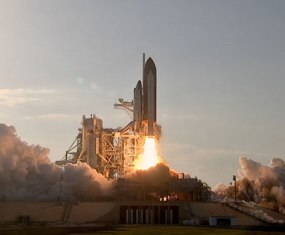|
Space Shuttle Discovery Launches on its Final Mission  Shuttle Discovery's Final Flight, Courtesy of NASA February 24 2011 | WMFE - NASA says several small pieces of foam fell from the external fuel tank of Space Shuttle Discovery as the Spacecraft lifted off from the Kennedy Space Center on its final mission. The issue occurred beyond a window of concern for the shuttle and is not expected to cause any problems.
NASA started flying Discovery in 1984, and she became an unofficial favorite of the shuttle Fleet. It was Discovery who was called into service to return America to space after the loss of Space shuttles Challenger in 1986 and Columbia in 2003. Among her other feats: Discovery launched the Hubble Space Telescope in 1990, and brought Astronaut John Glenn back into space in 1998. Mission manager Mike Moses was excited after liftoff to talk about the sheer precision of Discovery’s performance at start of her final flight, " It is truly amazing Iget the emotional choke up of seeing the vehicle launch and putting humans in space. From an engineering perspective. It is a technical marvel to see the main engines and SRBs carry this vehicle into orbit. The amount of energy that we’re putting in that thing to get it into orbit and then heading to mach 25 is a truly outstanding event." SRB’s are the Solid Rocket Boosters that return to earth after leaving the shuttle about 2 minutes into liftoff by the way. For its final mission Discovery is carrying a variety of cargo and supplies to the International space station. One module called the Leonardo PMM or permanent Multipurpose module, will act a kind of closet for storing things at the station. Another module is called the Express Logistics Carrier and will be fitted outside the station during 2 scheduled spacewalks. There are experiments on fungi, rats, and human hair on board as well. One the most interesting crew members isn’t even human. Payload manager Scott Higginbotham says Robonaut2, a robot shaped like a human torso, with a head like Ironman, will hopefully lead to his deployment outside the space station to help people using his dexterous arms to work on experiments that are to dangerous for spacewalkers. NASA will check up on small pieces of foam that fell away from the shuttle’s external fuel tank on launch. Discovery is scheduled to land at the Kennedy space Center next month. It will be prepared into a ready position just in case it’s needed for testing, and eventually head to retirement at a museum or one of the many NASA centers vying for a piece of space history. Now only two shuttle missions remain on NASA's roster. |
|
|